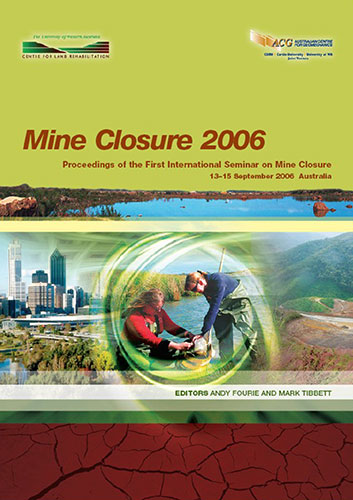The French Experience of Post Mining Management

|
Authors: Didier, C; Leloup, J Paper is not available for download Contact Us |
DOI https://doi.org/10.36487/ACG_repo/605_12
Cite As:
Didier, C & Leloup, J 2006, 'The French Experience of Post Mining Management', in AB Fourie & M Tibbett (eds), Mine Closure 2006: Proceedings of the First International Seminar on Mine Closure, Australian Centre for Geomechanics, Perth, pp. 199-210, https://doi.org/10.36487/ACG_repo/605_12
Abstract:
During the centuries, French mining activity contributed, for a large amount, to the national industrial development. During the last few decades, under the combined effect of the resources exhaustion and international competition, the very large majority of French mining sites gradually closed down. Formerly symbol of pride and solidarity, mining activity is now frequently associated with post-mining harmful effects. As a matter of fact, the mine closure do not result in the complete and definitive eradication of risks for people, activities and goods located in the area of influence of abandoned mines. Thus, during the period, which follows exploitation and traditionally called "post-mining", many disorders may develop, sometimes just after mine closure but sometimes quite long time later. In addition to potential instability development (subsidence, collapses), some abandoned mining sites can be affected by severe hydrogeological phenomena (floods), dangerous mine gas emissions on surface or environmental degradation (ground or water pollution). The paper presents briefly the French mining historical context that leads to the present situation. It then identifies and describes the major kinds of residual risks and harmful effects that may affect the abandoned French mine sites. The national prevention policy is then discussed, explaining the French mining legal scope recent evolutions as well as the major prevention programs that are developed on the national territory. Finally, a short description of the post-mining risk management organisation is given to explain the co- ordination between public services or establishments involved in the risk management process.
References:
Edict No. 95-696 of 9th May 1995 Modified by edicts No. 2001-205 and 2001-209 and Order of 8th September 2004.
Law No. 99-245 of 30th March 1999 relative to responsibility in terms of damages related to mining extraction and
post-mining risk prevention.
Didier, C. (2001) Methodological guideline for mining works closure application. INERIS-DRS-01-25750/R01.
April 2001, 130 p.
Law No. 95-101 of 2 February 1995 applied by Edict No. 95-101 of 5 October 1995 for Natural Hazard PPR. The
extension of PPR to mining risks is defined in law No. 99-245 of 30th March 1999 and edict No. 2000-547 of
16th June 2000.
Didier, C. and Leloup, J. (2005) The MRPP: a powerful operational regulatory tool to prevent and manage post-mining
risks. Proceedings of the 2nd post-mining symposium GISOS 2005. 16-18 November 2005. Nancy (France),
12 p.
Elaboration of Mining Risk Prevention Plan. Methodological guideline established under the scientific co-ordination
of INERIS. INERIS-DRS-04-51198/R01. 30 June 2004.
Couffin, S., Bigarre, P., Bennani, M. and Josien, J.P. (2003) Permanent real time microseismic monitoring of
abandoned mines for public safety. Proceedings of the 6th International Symposium on Field Measurements
in Geomechanics FMGM 2003, 15-18 septembre 2003, Oslo, Norvège, pp. 437-444.
The French Experience of Post Mining Management C. Didier, J. Leloup
210 Mine Closure 2006, Perth, Australia
© Copyright 2026, Australian Centre for Geomechanics (ACG), The University of Western Australia. All rights reserved.
View copyright/legal information
Please direct any queries or error reports to repository-acg@uwa.edu.au
View copyright/legal information
Please direct any queries or error reports to repository-acg@uwa.edu.au